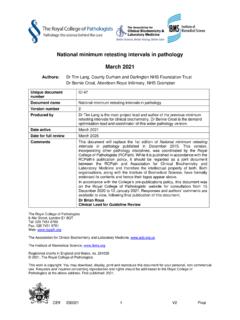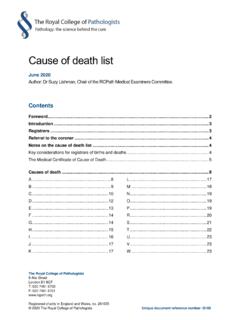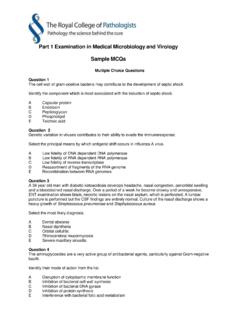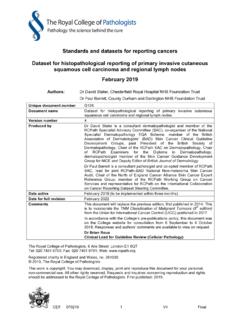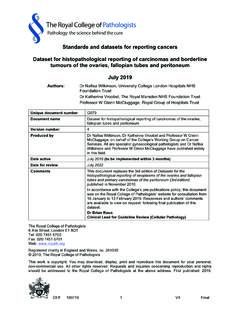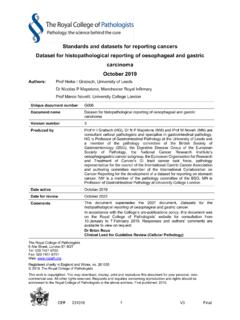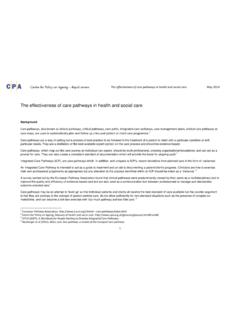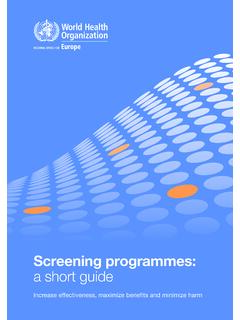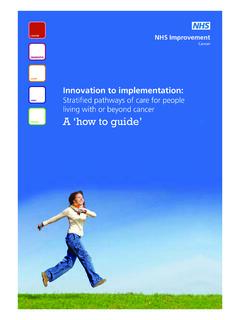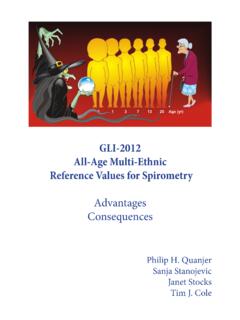Transcription of G086 Tissue pathways for diagnostic cytopathology For ...
1 Tissue pathways for diagnostic cytopathology October 2019. Authors: Dr Paul Cross, Gateshead Health NHS Foundation Trust (NHSFT). Dr Ashish Chandra, Guy's and St Thomas' NHSFT. Dr Anthony Maddox, West Hertfordshire Hospitals NHS Trust Ms Nadira Narine, Manchester University NHSFT. Dr Thomas Giles, Royal Liverpool and Broadgreen University Hospital NHS Trust Unique document number G086. Document name Tissue pathways for diagnostic cytopathology Version number 2. Produced by Dr Paul Cross (MBBS, FRCPath, Consultant Cellular Pathologist), Dr Ashish Chandra (FRCPath DipRCPath [Cytol], Lead Consultant for cytopathology and Urological Histopathology), Dr Anthony Maddox (MBBS, FRCPath Consultant Cyto/Histopathologist, Lead Clinician for Cellular Pathology), Ms Nadira Narine (MSc, FIBMS, Consultant Biomedical Scientist) and Dr Thomas Giles (MB ChB, FRPath, Consultant Cytopathologist), on behalf of the Working Group on Cancer Services.
2 Date active October 2019. Date for full review October 2024. Comments This document will replace the 1st edition of Tissue pathways for exfoliative cytology and fine needle aspiration cytology published in January 2010. In accordance with the College's pre-publications policy, this document was on The Royal College of Pathologists' website for consultation from 2 May to 30 May 2019. Responses and authors' comments are available to view following final publication of this Tissue pathway . Dr Brian Rous Clinical Lead for Guideline Review The Royal College of Pathologists 6 Alie Street, London E1 8QT.
3 Tel: 020 7451 6700. Fax: 020 7451 6701. Web: Registered charity in England and Wales, no. 261035. 2019, The Royal College of Pathologists This work is copyright. You may download, display, print and reproduce this document for your personal, non-commercial use. Requests and inquiries concerning reproduction and rights should be addressed to the Royal College of Pathologists at the above address. First published: 2019. CEff 301019 1 V2 Final Contents Foreword .. 3. 1 Introduction .. 4. 2 Generic issues relating to staffing, workload and 4. 3 Sample types .. 5. 4 Staining.
4 17. 5 Ancillary testing .. 17. 6 cytopathology reporting .. 19. 7 Cervical 24. 8 Quality .. 24. 9 Criteria for audit .. 24. 10 References .. 26. Appendix A Summary table explanation of grades of evidence .. 31. Appendix B AGREE II guideline monitoring 33. NICE has accredited the process used by the Royal College of Pathologists to produce its Tissue pathways . Accreditation is valid for five years from 25 July 2017. More information on accreditation can be viewed at For full details on our accreditation visit: CEff 301019 2 V2 Final Foreword The Tissue pathways published by the Royal College of Pathologists (RCPath) are guidelines that enable pathologists to deal with routine pathological specimens in a consistent manner and to a high standard.
5 This ensures that accurate diagnostic and prognostic information is available to clinicians for optimal patient care and ensures appropriate management for specific clinical circumstances. This guideline has been developed to cover most common circumstances. However, we recognise that guidelines cannot anticipate every pathological specimen type and clinical scenario. Occasional variation from the practice recommended in this guideline may therefore be required to report a specimen in a way that maximises benefit to the patient. The guidelines themselves constitute the tools for implementation and dissemination of good practice.
6 The following stakeholders were contacted to consult on this document: British Association for cytopathology British Thoracic Society United Kingdom Endocrine Pathology Society UK Breast Pathology Group No major organisational changes or cost implications have been identified that would hinder the implementation of the Tissue pathway , but some training and backfill may be required to allow cytology staff to fulfill the requirements of this guidance. The information used to develop this Tissue pathway was collected from electronic searches of the medical literature, previous recommendations of the RCPath and local guidelines in the UK.
7 Published evidence was evaluated using modified SIGN guidance (see Appendix A). Consensus of evidence in the Tissue pathway was achieved by expert review. The sections of this Tissue pathway that indicate compliance with each of the AGREE II standards are indicated in Appendix B. A formal revision cycle for all Tissue pathways takes place on a five-year basis. However, each year the College will ask the author(s) of the Tissue pathways , in conjunction with the relevant subspecialty adviser to the College, to consider whether or not the document needs to be updated or revised.
8 A full consultation process will be undertaken if major revisions are required. If minor revisions are required, an abridged consultation process will be undertaken whereby a short note of the proposed changes will be placed on the College website for two weeks for members'. attention. If members do not object to the changes, the short notice of change will be incorporated into the pathways and the full revised version (incorporating the changes) will replace the existing version on the publications page of the College. All changes will be documented in the data control section of the relevant pathway .
9 This Tissue pathway was reviewed by the Clinical effectiveness department, Lay Governance Group and Working Group on Cancer Services and placed on the College website for consultation with the membership from 2 May to 30 May 2019. All comments received from the Working Group and membership were addressed by the authors to the satisfaction of the Chair of the Working Group and the Clinical Lead for Guideline Review. This Tissue pathway was developed without external funding to the writing group. The College requires the authors of Tissue pathways to provide a list of potential conflicts of interest; these are monitored by the Clinical effectiveness department and are available on request.
10 The authors have declared no conflicts of interest. CEff 301019 3 V2 Final 1 Introduction Summary of pathways document The original Tissue pathways for exfoliative cytology and fine needle aspiration cytology was issued by the RCPath in January 2010. It was of great value in ensuring consistency of approach and handling of cytopathology samples. cytopathology can deliver a robust diagnosis based on purely morphological grounds, with a rapid turnaround time, in many situations. However, much has changed in the field of cytopathology since the original document was issued.


